
|
In this review PCSTATS is testing the Intel P67-based Gigabyte GA-P67A-UD4 motherboard. This is a mainstream ATX motherboard with a great set of workstation features and connectivity, all on a sleek matt-black PCB that looks fantastic in black computer chassis.
75% Rating: 
|
|
|
|
Home >
Reviews >
Motherboards >
Gigabyte GA-P67A-UD4 |
|
|
The upside to a recall brought about by an obscure and statistically probable SATA
II controller bug are the great deals that inevitably come from it. Consumers
are fickle, look carefully and you may find Intel P67 boards that offer 90% of the
features of a new Intel
Z68 platform that are going for next to nothing. Have a B2-stepping P67 board already? Easy fix -
swap it out with the manufacturer for one built on a B3-stepping P67 chipset or move
your storage devices to the SATA III ports. At the very worst, plunk down $25 on
a HighPoint Rocket 620 two-port SATA III PCIex1 card.
In this review PCSTATS is testing the Intel P67-based Gigabyte
GA-P67A-UD4 motherboard. This is
a mainstream ATX motherboard with a great set of workstation features and connectivity, all on a
sleek matt-black PCB that looks fantastic in black computer chassis. The
board supports 32nm socket LGA1155 2nd Generation Intel Core i3/i5/i7 2xxx-series 'SandyBridge' processors,
such as the Core i5 2500K, and can handle dual graphics cards.
The Gigabyte GA-P67A-UD4 motherboard is equipped with
four 1.5v DDR-3 memory slots that accommodate up to 32GB of
dual channel DDR3-1066/1333/1600/1866/2133 memory (4GB for 32-bit operating systems). Extreme Memory Profile (XMP)
RAM is supported, such as Crucial's Ballistix memory modules.
On the graphics card front, the P67A-UD4 will run a single
PCI Express 2.0 videocard on 16 full lanes of PCIe bandwidth. Need more pixel
cracking speed? Slap in a pair of nVidia Geforce or ATI Radeon videocards and configure
two-way SLI/Crossfire in x8/x8 mode. Three PCI Express x1 slots and two
legacy PCI slots round out the expansion options available from this Intel P67
motherboard.
Moving on
to storage; the
GA-P67A-UD4 board dishes out four 3Gb/s SATA II ports and two 6Gb/s SATA
III ports via the Intel P67 chipset for hard drives (RAID 0/1/5/10)
or optical drives. An extra pair of 6Gb/s eSATA III ports are
positioned at the rear I/O for external hard drives. These support RAID 0/1 and come care
of a Marvell SE9128 SATA III controller. For all this, expect to pay about $160 bucks for the Gigabyte
GA-P67A-UD4 motherboard at online shops like Canada Computers, NCIX and Newegg.
 |
|
Gigabyte GA-P67A-UD4
Motherboard |
|
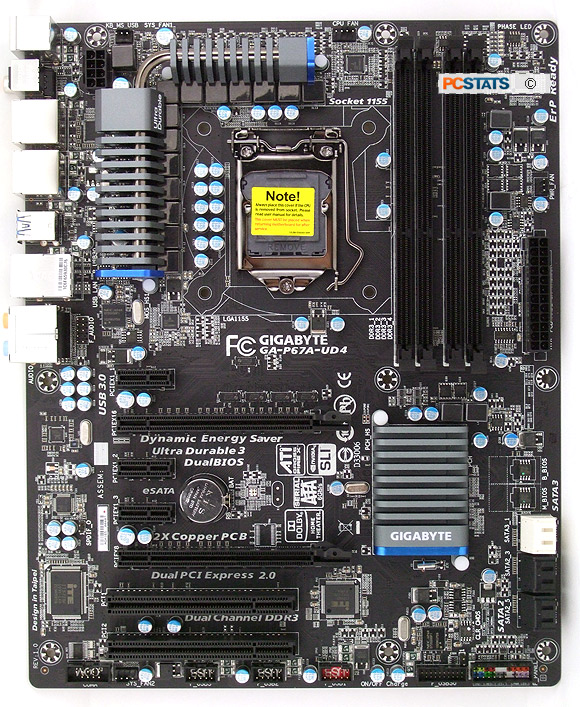

|
|
|
|
INCLUDES: User's Manual,
Driver DVD, (4) SATA cables, 2-way SLI bridge, I/O
Shield. |
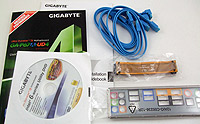
|
|
Chipsets: Intel P67
Express
CPU Support: Intel Socket
LGA1155
Memory Type: Dual Channel
DDR3
Videocard Support: (2) PCI Express
x16 2.0 (x16 or x8/x8)
Average Price at time of review:
$160 | |
| |
The
Gigabyte GA-P67A-UD4 is not short on USB ports by any stretch of the imagination
- it has four USB3.0 ports (two at the rear I/O, two via header) from a pair of
NEC D720200's and
no less than
eight USB 2.0 ports at the rear I/O!
Other random features include; 3x USB power boost, dual
BIOS's, On/Off Charge for recharging devices like the iPhone and a whack of
board level components to ensure the stability and longevity of this
motherboard. Well, not the 'b2' stepping Intel P67 chipset... but the solid
state capacitors, low RDS MOSFETS and so forth.
At the back of
the Gigabyte GA-P67A-UD4 motherboard you'll find (2) SuperSpeed USB 3.0 ports, a gigabit Ethernet jack, an optical and
coaxial S/PDIF out, (2) eSATA III ports and the 7.1-channel audio-out headphone jacks. The audio system is based off a Realtek ACL892 codec and is Dolby Home Theatre compliant.
As with
most Intel P67 platforms, there is
no support for legacy IDE hard drives or FDD devices whatsoever. The box contents
are pretty slim too; you get four SATA cables, an I/O shield, SLI
bridge connector and a paper cut if
you're lucky. The board's warranty is three years from the date of manufacture for US/Canadian
consumers.
|
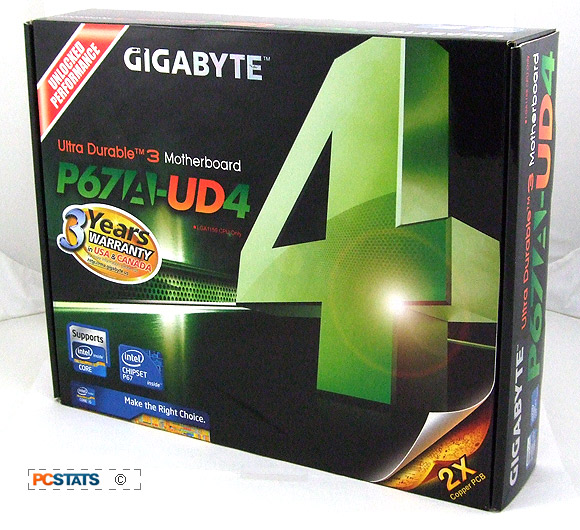
Gigabyte backs the GA-P67A-UD4
motherboard with a three year warranty in the US and
Canada.
|
LGA1155 Heat Sink / Thermal
Solutions
While Intel has created several different heatsink
sizes in recent years, the socket LGA1155 'SandyBridge' CPU cooler
is thankfully interchangeable with previous socket LGA1156 heatsinks.
The stock 'SandyBridge' heatsink is decent, but
better aftermarket CPU coolers are easy enough to
find so there's no good reason not to upgrade. PCSTATS likes the
low noise Noctua coolers and tower-style Xigmatek's, but really just about anything from Zalman to Scythe
will cool quieter than a stock
Intel HSF.
Clearance around the GA-P67A-UD4's CPU socket is
average, some low overhanging thermal solutions may interfere with
the VRM heatsinks or memory modules if fins extend much beyond the Intel heatsink
retention holes.
|
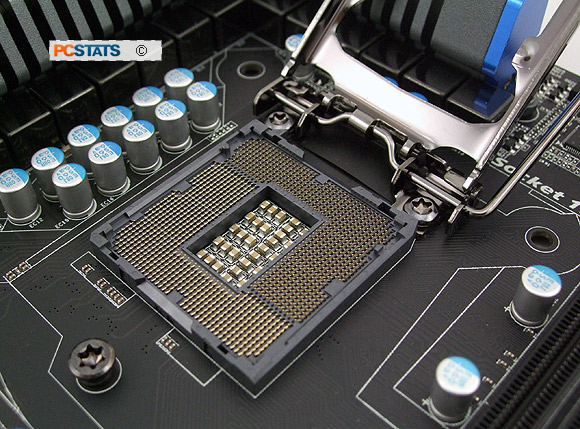
LGA1155 CPU socket for 32nm SandyBridge Processors. Principles of
installing an LGA processor are covered in
this Beginners
Guide.
|
In case
you want to install additional fans for dual videocard set
ups, the P67A-UD4 board has two PWM and two 3-pin fan headers ready
for use.
Intel P67 Express Chipset
 With graphics and memory now handled by the CPU, the Intel P67 chipset
doesn't need a very fast link to the processor. Thus, instead of complex and expensive-to-produce
QPI link, Intel uses a 20Gb/s DMI link between the Intel P67
chipset and LGA1155 processors. The roles of the Northbridge and Southbridge chipsets have been merged into what Intel
calls a PCH, or Platform Controller Hub. With graphics and memory now handled by the CPU, the Intel P67 chipset
doesn't need a very fast link to the processor. Thus, instead of complex and expensive-to-produce
QPI link, Intel uses a 20Gb/s DMI link between the Intel P67
chipset and LGA1155 processors. The roles of the Northbridge and Southbridge chipsets have been merged into what Intel
calls a PCH, or Platform Controller Hub.
Intel's P67 PCH supplies eight PCI Express lanes to the computer system
for devices like the SATA ports, LAN, USB and PCIex1
slots. The 16 PCIe lanes for graphics cards are drawn directly from the 'SandyBridge' CPU, this has a
nice side benefit of helping to cut down on system latency.
|
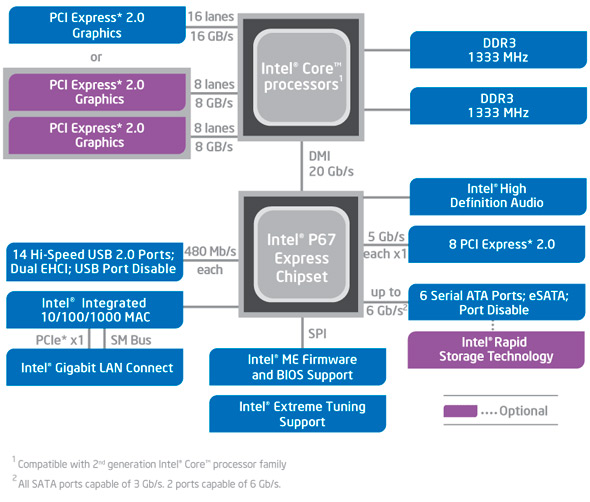
The Intel P67 Express Chipset block
diagram
|
Enthusiasts familiar with the storage and
media capabilities of Intel's ICH10R southbridge will find a lot in common with the
P67 chipset. It provides 14 USB 2.0 ports, four SATA 3Gb/s and two SATA
6Gb/s ports with support for RAID 0/1/5/10 modes, audio and gigabit
Ethernet.
| Intel Chipset Feature
Comparison |
|
Intel Z68 Express |
Intel P67
Express
|
Intel H67
Express |
Intel X58
Express |
| CPU |
LGA 1155
Core i5/i7 2nd Gen. |
LGA 1155
Core i5/i7 2nd Gen. |
LGA 1155
Core i5/i7 2nd Gen. |
LGA 1366
Core i7 |
| Chipset Code Name |
Couger Point (65nm) |
Couger Point (65nm) |
Couger Point (65nm) |
Tylersburg (65nm) |
| Bus Interface / Speed |
DMI 20Gb/s |
DMI 20Gb/s |
DMI 20Gb/s |
QPI 25.6Gb/s |
| Memory Support |
DDR3-1333, dual channel |
DDR3-1333, dual channel |
DDR3-1333, dual channel |
DDR3 1066, triple channel |
| Maximum Memory Capacity |
32GB (64-bit) |
32GB (64-bit) |
32GB (64-bit) |
24GB (64-bit) |
| Integrated Graphics |
Yes. via CPU |
- |
Yes. via CPU |
- |
| Integrated Graphics Ports |
HDMI, DVI, DP, VGA |
- |
HDMI, DVI, DP, VGA |
- |
| PCI Express 2.0 Lanes |
8 |
8 |
8 |
36 |
| PCI Express x1 Lanes |
0 |
0 |
0 |
6 |
| Intel Rapid Storage Technology |
Yes |
Yes |
Yes |
Yes |
| Intel Smart Response Technology |
Yes |
- |
- |
- |
| SATA 6Gb/s | SATA 3Gb/s | IDE Ports |
2/4/0 |
2/4/0 |
2/4/0 |
0/6/0 |
| RAID |
0, 1, 5, 10 |
0, 1, 5, 10 |
0, 1, 5, 10 |
0, 1, 5, 10 (via ICH10R) |
| Intelgrated LAN |
10/100/1000 MAC |
10/100/1000 MAC |
10/100/1000 MAC |
- |
| USB 3.0 Ports |
0 |
0 |
0 |
0 |
| USB 2.0 Ports |
14 |
14 |
14 |
12 |
| PCI Masters |
0 |
0 |
0 |
6 |
| Intel High Definition Audio |
Yes |
Yes |
Yes |
Yes | | |
In the above Chipset Feature Comparison chart you can see
how all three of 6-series Intel chipsets compare to one another a little easier. The
major difference between the Intel P67 Express and H67 chipsets is that the
former lacks the H67's capabilities to output integrated graphics from the processor. Moving forward, the newer Intel Z68 Express chipset is essentially a combination of the feature sets
of the Intel P67 and H67, with a couple bonus extras.
Next up, a close up look at all the Gigabyte GA-P67A-UD4 motherboard has to
offer.
|

